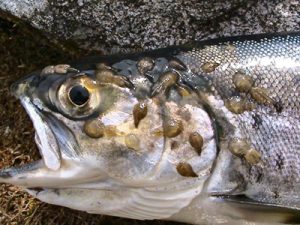Sea lice are copepods and have been around since Salmon have been in water. Not a public health concern but a massive threat for salmon farmers.
Zye Angiwan of Immortal News reports
Salmon farms are facing a large parasitic problem, which has disrupted production all over the world. An uptick in sea lice has become a growing problem in salmon farms, jacking up wholesale prices to as high as 50% from last year for salmon products, from fillets to lox. The tiny sea lice attach themselves to the fish and feed on them, eventually killing them or making them inedible, New York Daily News reports. The sea lice have infested salmon farms in the United States, Scotland, Canada, Norway and Chile – all major global suppliers of the popular fish. Scientists and fish farmers are working to control the pesky crustaceans, which costs the international aquaculture industry around $1 billion yearly. 
Jake Elliott, vice president of Cooke Aquaculture in Blacks Harbour, New Brunswick, said, Our work has to be quicker than the evolution of the lice. Experts believe that the problem needs a new slew of advanced technology coupled with older tools such as pesticides. New strategies for breeding the high-protein fish for genetic resistance is necessary, as our methods such as bathing the salmon in warm water to remove the lice or using underwater lasers to take the parasites out. Salmon farmers consider sea lice the biggest threat to their industry, saying that the chronic problem is making the fish more expensive for consumers. The parasites thrive in the tightly packed ocean pens that fish farmers use, according to Shawn Robinson, a scientist with the Canadian Department of Fisheries and Oceans. “There are not enough tools right now to allow the farmer to really effectively deal with it,” he said. Atlantic salmon have managed to keep the sea lice at bay in the wild for centuries, and fish farmers have been managing them for many years. The lice were first identified as a problem in 1994, but the bigger concerns came when the sea lice started evolving to resist the tools farmers used to eradicate them. The chances of sea lice making their way to market-sold salmon is very slim, and should it happen, accidentally consuming a louse would not pose a threat to humans.
